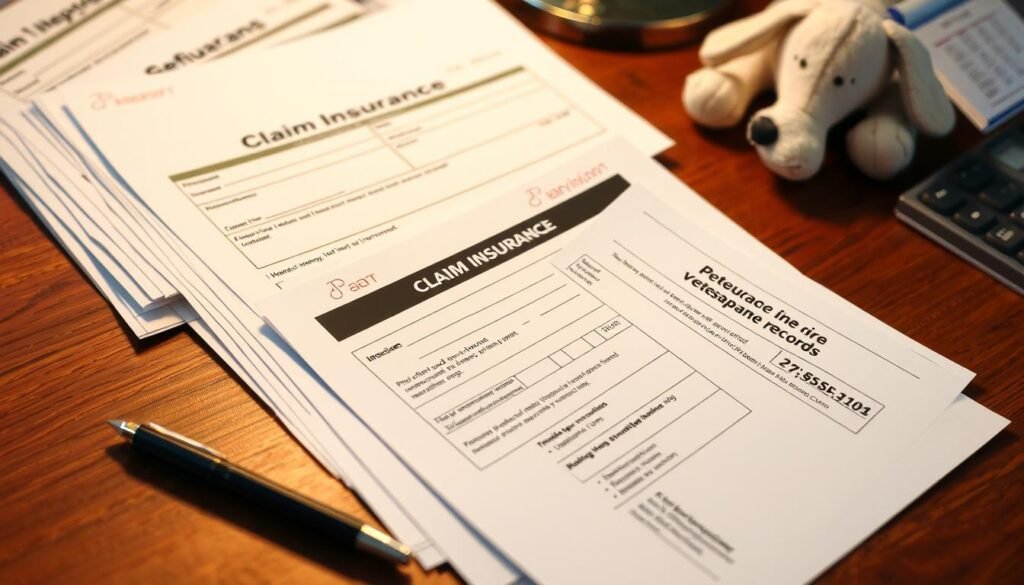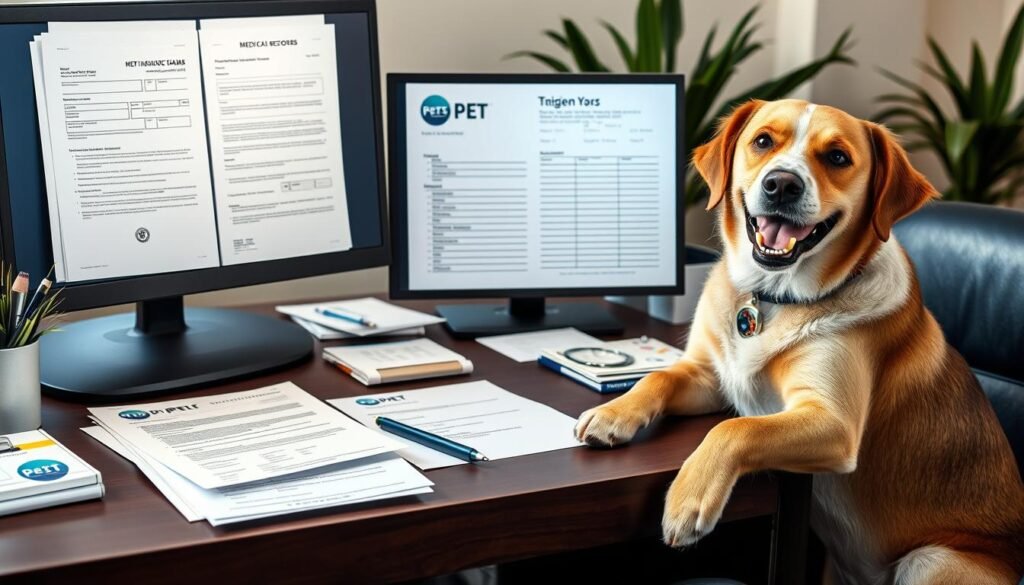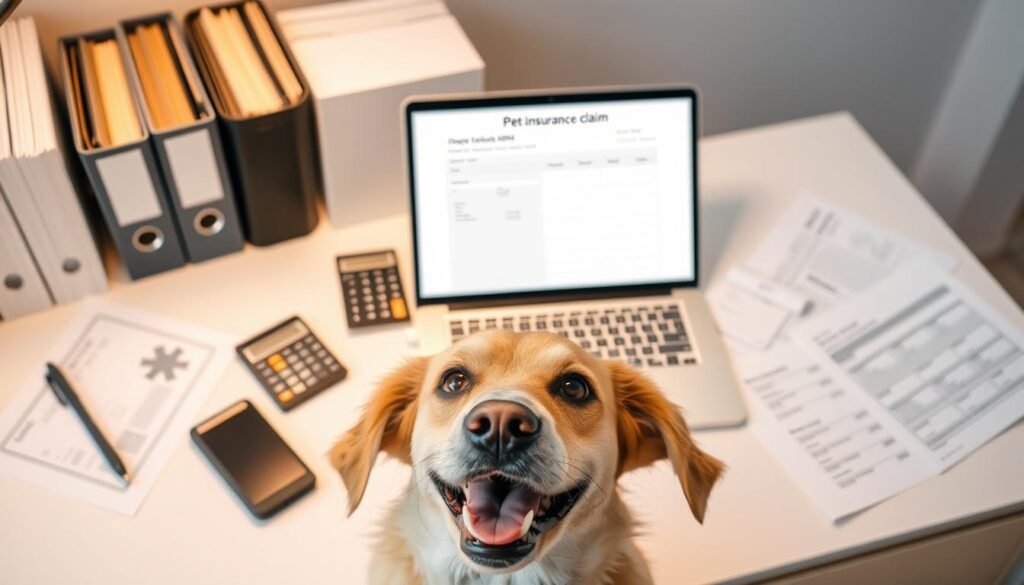8 Easy Steps on How to File a Pet Insurance Claim for Your Dog
Ever wondered how to file a pet insurance claim for your dog? It’s important to know the steps, whether it’s for an accident or a long-term health issue. In this guide, we’ll show you the 8 key steps to file a claim for your dog. This way, you’ll get the most help with your vet bills.
Key Takeaways
- Pet insurance policies often have a waiting period of 10 to 30 days before coverage begins1.
- Many insurers require claims to be filed within a few months (e.g., 60 days) of the veterinary visit2.
- Reimbursement rates typically range from 70-90% of eligible expenses, with a 20% co-pay by the pet owner23.,
- Detailed medical records are key to prove the condition isn’t pre-existing and is covered3.
- Reviewing your policy annually keeps you updated on coverage and any changes3.
Understanding Pet Insurance Claims: The Basics

As a pet owner, knowing how pet insurance claims work is key. This knowledge helps you get the most from your pet policy coverage. You pay the vet first and then send in a claim for canine medical reimbursement4. This way, you can get your pet the care they need, and the insurance takes care of the veterinary bill submission.
What is a Pet Insurance Reimbursement Model?
In this model, you pay the vet directly for your dog’s care. Then, you send a claim to your insurance for dog accident and illness protection. You’ll get back a part of the pet healthcare expenses based on your policy5.
Common Types of Coverage Available
Pet insurance covers many services like accidents, illnesses, and surgeries. The best plans also include wellness care for prevention5. Knowing what’s covered helps you pick the right plan for your pet and budget.
Key Terms You Need to Know
Get to know terms like deductibles, co-pays, and coverage limits. These help you figure out what you’ll pay and what’s covered. Also, watch out for exclusions like pre-existing conditions that might affect your claims5.
Learning about pet insurance claims and coverage empowers you. It helps you make smart choices and ensure your pet gets the care they need. By understanding these basics, you’ll be ready to get the most from your pet policy coverage.
| Breed | Average Claim Amount for Diabetes |
|---|---|
| Burmese Cat | $597.564 |
| Scottish Fold Cat | $179.854 |
| Alaskan Husky | $205.604 |
| Great Dane | $221.564 |
“Understanding the basics of pet insurance claims and coverage can empower you to make informed decisions and ensure your furry friend receives the care they deserve.”
Preparing Essential Documentation Before Filing

Getting your pet insurance claim approved starts with the right documents. Having all the necessary claim documents ready can make the process easier and boost your chances of approval.6 You’ll need to gather things like veterinary invoices, medical records, and SOAP notes. Also, don’t forget proof of payment and any extra records your insurance might ask for7.
Get these documents as soon as your pet’s treatment is done. It’s also smart to keep copies of everything you send in for your records6. Some insurance companies might need special forms or more info, so check your policy or call them to find out what they need7.
Being thorough and organized with your claim documents helps a lot. Spending time to get everything right can really help your claim go through smoothly67.
Pet Insurance Claim for Dogs: Documentation Requirements

Getting through the pet insurance claims process is easier with the right documents. As a dog owner, you’ll need to give your insurance company some important information. Let’s look at what you need for pet insurance claims.
Veterinary Bills and Invoices
Veterinary bills and invoices are key for your claim. They should list the date of service, diagnosis, treatments, and costs8. Make sure your invoices are clear and detailed to speed up the process.
Medical Records and SOAP Notes
Your dog’s medical records and SOAP notes are very helpful. They show the treatment plan and why it’s needed8. These records give a full picture of your pet’s health and the treatments they got.
Proof of Payment Documentation
You’ll need proof of payment for the vet services to get reimbursed. This can be receipts, credit card statements, or other proof that you paid8. For ongoing conditions, you might also need past medical records to show the condition isn’t pre-existing.
By collecting these important documents, you’re ready to handle the canine insurance claims process. The more detailed and organized your submission, the easier the claims process will be.
“Thorough documentation is the key to successful pet insurance claims. Invest the time upfront to ensure you have all the necessary information to support your dog’s treatment.”
With the right strategy, you can make the dog owner claims guide easier. This way, you can get the most out of your pet insurance benefits for dogs8.
Understanding Waiting Periods and Coverage Limitations

When you’re looking into pet insurance, it’s key to know about waiting periods and coverage limits9. Accident coverage waits range from 1 day to 5 days across different companies9. Illness coverage waits are usually 14 days to 30 days9. Orthopedic conditions can have waits from 14 days up to six months or longer910.
Knowing these waiting times helps you plan for your pet’s health costs. Most pet insurance covers curable pre-existing conditions after they’ve been symptom-free for 180 days to 12 months9. Getting pet insurance early can help avoid long waits and reduce the chance of a condition being seen as pre-existing10. But, remember, no pet insurance covers pre-existing conditions10. If your pet has a health issue during the wait, the claim won’t be covered, and new issues might be seen as pre-existing10.
Also, it’s vital to understand coverage limits like annual or lifetime maximums, per-incident caps, and excluded conditions9. These can affect how much you get back for your pet’s medical costs. They help you plan for any extra costs9.
Waiting periods and coverage limits help insurance companies avoid bad choices and fraud by pet owners9. Knowing these parts of your pet insurance policy lets you make smart choices and get the most from your coverage9.
| Type of Coverage | Typical Waiting Period |
|---|---|
| Accident | 1-5 days9 |
| Illness | 14-30 days9 |
| Orthopedic Conditions | 14 days to 6 months or longer9 |
By understanding your pet insurance’s waiting periods and coverage limits, you can better handle claims. This ensures your pet gets the care they need910.
Step-by-Step Claim Submission Process

Filing a pet insurance claim is easy with the help of pet insurance companies. They offer online portals and mobile apps for a smooth process. This way, you can get your money back fast and without hassle11.
Online Submission Methods
Pet insurance providers have made online claim submission easy. You can upload vet bills and medical records with just a few clicks. Some even let you track your claim in real-time11.
Mobile App Filing Options
Many pet insurance companies have mobile apps for filing claims. You can submit claims, upload photos of invoices, and more from your phone12. This makes filing claims quick and easy13.
Traditional Paper Claims
If you prefer paper, some pet insurance companies accept mail or fax claims. This method is slower but works for those who don’t like digital13. Make sure to include all needed documents to avoid delays and get the most reimbursement.
Knowing your options for filing claims helps you choose the best one for you. Whether it’s online, through an app, or paper, the goal is to file your claim correctly and on time. This speeds up getting your money back.
Tracking Your Claim Status and Processing Time
![]()
After you submit a pet insurance claim, you might wonder about its status and when you’ll get reimbursed. Luckily, most insurers make it easy to track your claim. You can do this through online portals, mobile apps, or direct communication14.
How long it takes to process a claim can vary. Some companies can handle the first claim in just two days. Then, they usually process the next ones in about 15 days14. But, remember, the first claim might take longer because they review your pet’s medical history carefully15.
To make the claim process smoother, be ready to respond fast to any requests for more info or documents. If you’re slow to provide these, it can delay your claim processing. So, it’s key to be quick and attentive15.
Many insurers have digital claim tracking systems. These let you see your claim’s status in real-time. This can make you feel more at ease and help you budget better14.
When your claim is approved, how much you get back depends on your policy’s deductible and reimbursement rate14. You can usually adjust these to fit your budget and needs14.
If your claim is approved, how you get paid back can also affect timing. For example, direct deposit can get you your money in just two days14.
Knowing about claim tracking and processing times helps you manage your pet’s healthcare costs better1415.
“Tracking your claim status and processing time is key to managing your pet’s healthcare expenses well.”
Common Reasons for Claim Denials
Dealing with pet insurance claims can be tough, and denied claims are common. Knowing why claims get denied is key to avoiding and fixing these problems16.
Pre-existing Conditions
Pre-existing conditions are a big reason for denied claims16. Many policies don’t cover medical issues that started before you got the policy. This means you might have to pay for these costs yourself.
Missing Documentation
Not having the right documents is another reason for denials16. Insurers need detailed medical records and proof of payment to process claims. Without these, your claim might get rejected or delayed.
Policy Exclusions
Some treatments or conditions might not be covered by your policy16. This includes things like wellness visits or certain health issues. Reading your policy carefully can help you avoid surprises.
If your claim is denied, don’t give up. You can appeal by providing more information or clarification16. You might also want to ask for an internal review. Looking into policy upgrades or changes can also help for the future16.
Understanding why claims get denied and taking steps to prevent it can make the process easier16. Being careful with your documents and staying informed can help your pet get the coverage they need.
Maximizing Your Reimbursement Amount
To get the most from your pet insurance, it’s important to know a few key things. Your policy’s reimbursement rate, deductible options, and coverage limits all affect how much you’ll pay17. Understanding these can help you save money.
Look for a plan with a high reimbursement rate, like 80% or 90% of eligible costs18. This can cut down on what you have to pay out of pocket. Also, choosing a lower deductible, like $200 or $500, can save you money each month compared to a $1,000 deductible17.
If your pet has ongoing health issues, an annual deductible might be better than a per-incident one. This way, you only pay the deductible once a year18. Some companies, like Embrace, offer deductibles that decrease by $50 each year you don’t file a claim17. Picking the right deductible and reimbursement options can help you manage costs and get the most from your insurance.
FAQ
What is a pet insurance reimbursement model?
Pet insurance usually works on a reimbursement model. You pay the vet first and then claim for reimbursement. Knowing this helps manage costs and ensures claims go smoothly.
What types of coverage are commonly available in pet insurance?
Pet insurance often covers accidents, illnesses, and more. It includes diagnostics, hospital stays, meds, and surgeries. Key terms are deductibles, co-pays, and how much you get back.
What kind of documentation is required for pet insurance claims?
You need the right documents for pet insurance claims. This includes vet bills, medical records, and proof of payment. The insurer might ask for more.
What are the specific documentation requirements for pet insurance claims?
Your vet bills should list the date, diagnosis, and costs. Medical records give treatment details. You’ll also need proof of payment.
Are there waiting periods and coverage limitations I should be aware of?
Most policies have a 10 to 30-day wait before you’re covered. Know about limits like annual maxes and excluded conditions.
What are the different claim submission methods available?
You can submit claims online, through apps, or by paper. Digital methods are quick and easy, letting you track your claim.
How can I track the status of my pet insurance claim?
Insurers let you track claims online or through apps. Times vary, but most aim for quick processing. Be ready to provide more info if needed.
What are some common reasons for pet insurance claim denials?
Claims can be denied for pre-existing conditions or missing info. Policy exclusions also play a part. Knowing this helps avoid issues.
How can I maximize my pet insurance reimbursement?
To get the most, know your policy’s details. Choose a plan with a high reimbursement rate and low deductible. Plans with annual deductibles are better for ongoing conditions.
Source Links
- How To File a Pet Insurance Claim
- How To File A Pet Insurance Claim For Your Pet’s Vet Bills | Bankrate
- How to File a Pet Insurance Claim: Step-by-Step Instructions
- Ins and Outs of Pet Insurance Claims | ASPCA Pet Health Insurance
- What Is Pet Insurance, How Does It Work & What Is Covered? A Pet Parent’s Guide
- Pet Insurance Claim Form: How to Complete and Submit One
- How to file a pet insurance claim and get reimbursed for veterinarian bills
- Embrace Pet Insurance Claim Info | Facts About Making Pet Insurance Claims & Submitting Claim Forms – Embrace Pet Insurance
- Pet Insurance Waiting Periods: Complete Guide – NerdWallet
- Pet Insurance Waiting Period | Learn about the Waiting Period for Pet Insurance
- How To File A Pet Insurance Claim
- How To Submit A Pet Insurance Claim With Spot Pet ? | Spot®
- How to File a Pet Insurance Claim – Lemonade Insurance
- Fetch® Pet Insurance Claims Process
- Nationwide Veterinarian FAQs | Claim & Policy Questions
- What To Do If Your Pet Insurance Claim Is Denied | Bankrate
- Why Choosing a Higher Pet Insurance Deductible Can Pay Off
- 3 Ways To Use Pet Insurance Like A Pro
editor's pick
latest video
news via inbox
Nulla turp dis cursus. Integer liberos euismod pretium faucibua

